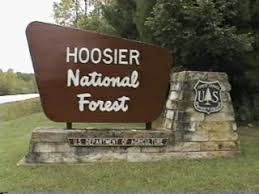
(BLOOMINGTON) – The Monroe County Commissioners, Monroe County Environmental Commission, Hoosier Environmental Council, and Indiana Forest Alliance and Dr. David Simcox filed a lawsuit Wednesday against the U.S. Forest Service (USFS).
The U.S. Forest Service plans to log 4,375 acres, repeatedly burn 13,500 acres, build 16.4 miles of logging roads, and apply herbicides on 1,970 acres all concentrated on ridges, slopes, and valleys in the Hoosier National Forest that drain into Monroe Reservoir.
The lawsuit filed in U.S. District Court in New Albany states the Forest Service plans would disrupt recreation along the Knobstone Trail – Indiana’s longest footpath.
The group is being represented by the public-interest law firm Eubanks & Associates, LLC.
The lawsuit asks the court to halt the project and send the issue back to the U.S. Forest Service for further analysis and a decision-making process consistent with the requirements of the National Environmental Policy Act.
Monroe County Commissioner Julie Thomas says the US Forest Service has dismissed all of their concerns and officials were left with no choice but to file a lawsuit.
“After nearly 18 months of commenting, asking for key reports, and objecting to this project and the U.S. Forest Service’s dismissal of all the important concerns, Monroe County and the plaintiffs were left with no other recourse but to file this suit, “ said Monroe County Commissioner Julie Thomas. “We are taking this action to protect our forest and the sole source of drinking water for 140,000 citizens in our region.”
Separately, the group has notified the U.S. Forest Service of their intent to sue the agency over alleged violations of the Endangered Species Act. They allege the logging and burning plan fails to properly take into account the impact on the endangered Indiana bat and the deeply threatened northern long-eared bat.
“The U.S Forest Service has seemed hell-bent on doing this project regardless of its dramatic impact on people, wildlife and the forest ecosystem in general,” said Jeff Stant, executive director of the Indiana Forest Alliance. “We’re taking a stand to show that refusing to consider alternatives is against the law.”
“It’s unfortunate that the Forest Service discarded a collaborative approach for this project, and instead chose to push ahead with a plan that needlessly increases the likelihood of damage to wildlife habitats, recreational trails, the waters of Lake Monroe, and which will boost the spread of invasive plants,” said Tim Maloney, senior policy director for the Hoosier Environmental Council.
The U.S. Forest Service declined to comment on the lawsuit saying it is a pending case.
The lawsuit can be viewed by clicking here.
The following are impacts from the proposed management plan:
Threaten Water Quality
Because Houston South is located in the Lake Monroe watershed, implementing the proposed management plan will compromise the drinking water supply for 120,000 people. Lake Monroe already suffers from excess nutrients, suspended sediment, and algae. Drinking water authorities spend hundreds of thousands of dollars to treat spikes in suspended solids (“turbidity”) to safely provide this water to the public. The project area contains many steep slopes with highly erodible soils, and the silt load from burning and logging will exacerbate these problems. Shallow bays are noticeably silting in and being clogged with invasive water plants. The Clean Water Act prohibits new pollutant loads when an impairment is present.
The U.S. Forest Service (USFS) says that Best Management Practices will prevent water pollution, but monitoring of other logging sites shows this is not true. In a Kentucky study, suspended sediments were 14 times higher during the first 17 months after cutting in a watershed where logging BMPs were used when compared to an uncut watershed (See source 1). A literature review indicates that in general, the effectiveness of BMPs for sediment ranges from 53 to 94% efficient during harvest and up to one year after harvesting (See source 2). Fishing on Lake Monroe will also likely suffer from increased sediment input.
Endanger Wildlife
In its present unlogged and unburned condition, the Houston South project area supports seven species of bats that are federally endangered or threatened, under consideration for this listing or state endangered or “species of special concern” (rare or range limited in Indiana, see source 3):
- Gray bat (Myotis grisecens)
Federally Endangered - Indiana bat (Myotis sodalis)
Federally Endangered - Northern long-eared (Myotis septentrionalis)
Federally Threatened, State Endangered - Little brown bat (Myotis lucifugus)
State Endangered - Tricolored bat (Perimyotis subflavus)
State Endangered, Federal Listing Under Review - Evening bat (Nycticeius humeralis)
State Endangered - Eastern red bat (Lasiurus borealis)
State Species of Special Concern
State counts indicate that White-Nose Syndrome, a disease that attacks cave-hibernating bats, has killed hundreds of thousands of Indiana bats and 90% or more of Northern long-eared, little brown, and tri-colored bats since it arrived in Indiana in 2009.

By burning and logging during the summer, the project will cut down, burn up, and engulfed in smoke maternity roosting trees for these bats, killing the mothers and their “pups.” Other animals that will likely be burned up or adversely affected by the logging and road construction include the state endangered Timber Rattlesnake and Cerulean Warbler and Species of Special Concern that lives or nest on or near the forest floor such as Eastern Box Turtle, Smoky, and Pygmy Shrew, Rough Green Snake, Worm Eating Warbler, Black and White Warbler, and Hooded Warbler.
Compromise Forest Health and Increase Invasive Species
The USFS claims that this timber harvest is required to regenerate early successional oak and hickory forests. However, the age class distribution table for the HNF indicates that about 10% of the HNF is in the 0-25 year age class, while less than 5% is in the > 100-year-old classes. Findings from the 2018 Purdue Climate Change study indicate that climate conditions will be more favorable for oak in the coming decades, suggesting that oak saplings will thrive without the intervention of logging, burning, and pesticide applications.
Jeopardize Outdoor Recreation
Outdoor recreation is one of the fastest-growing components of Indiana’s tourism industry, generating some $15.7 billion in annual consumer spending and creating 143,000 jobs in Indiana, according to the Outdoor Industry Association. This project will consume a significant part of the most popular horseback riding area in the HNF and force repeated closures of other horseback riding trails. The project will force closures or reroutes of the Knobstone Trail, the state’s longest and most famous backpacking trail, as well as the Fork Ridge and other hiking trails.
Volunteers helped construct and maintain many of these trails, but the volunteer pool is likely to dry up if trails are destroyed or repeatedly closed due to logging and burning. Several miles of the project is directly adjacent to the southern border of the Charles Deam Wilderness. This logging project will diminish the recreational experiences within the largest concentration of national and state forest public lands and the only federal wilderness area in the lower midwest (Indiana, Ohio, and Illinois) where wildland for such experiences is extremely limited.
Exacerbate Climate Change
The USFS is required to consider the cumulative impacts of its actions, including the release of greenhouse gases. While admitting the project will contribute to carbon emissions, the Forest Service has not considered doing this. Since the latest 2006 Forest Plan, global climate change projections have become much direr. The Houston South proposal does not even reference the Intergovernmental Panel on Climate Change report published in 2018 that emphasizes the importance of reducing carbon emissions and increasing carbon sequestration (see IPCC reports). USFS claims the project will contribute only small amounts of carbon through logging and burning activities. Furthermore, the agency has not considered alternatives that contribute less or have a positive impact on carbon sequestration.

Examine Alternatives
The USFS is required to consider alternatives to the proposed action at Houston South. The USFS has not demonstrated that they considered the impacts on municipal water supplies. Some 63,000 acres of the HNF have the same management prescription (“Management Area 2.8) under the HNF Management Plan as Houston South but lie within watersheds that are not used for drinking water. Many groups have asked the USFS to consider harvesting and burning in those areas instead. However, other than taking “no action,” the USFS has not considered any alternatives to this drastic plan.



